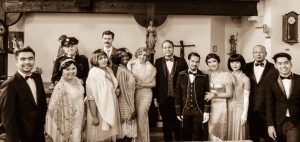 Sing to love …love we never knew before
Sing to love …love we never knew before
Two fault-lines always ends up scuppering my enjoyment of Die Fledermaus. One is the not terribly funny situation which underpins the plot, and the passages of spoken dialogue through which opera singers labour to deliver it; the other is the anti-climactic third act, set in a lock-up, which contains only two substantial musical numbers and unravels the intrigue at tedious length
I turn your morals upside down and set your spirit free,” Prince Orlofsky tells us in Die Fledermaus. His words are barbed, for in Johann Strauss II’s critique of hedonism, the pursuit of pleasure has its downside. The would-be adulterer Eisenstein unsuccessfully tries to pick up his own disguised wife, Rosalinde, at Orlofsky’s party, only to discover, by the cold light of day, that she’s been carrying on behind his back with her ex-lover Alfred. At the same bash, prison governor Frank tries his luck with the chambermaid – and aspiring actor – Adele and faces possible blackmail the following morning. For all its wit and humour, the operetta ends in a jail. As the hangovers kick in, comeuppances await.
Centred around the extravagant ball, the events of Die Fledermaus are set to a rich, romantic score by Johann Strauss II featuring some of the most irresistible melodies ever written for the stage. Strauss embellishes the opera with a vivid palette of waltzes, duets and orchestral pizazz that is hard to match. The operetta genre reached a pinnacle in Die Fledermaus and it is simply a wonderful way to spend an evening in the theatre.
Karlene’s extra “superwoman” being has too flushed me down to that time capsule and bring the action forward to Vienna in the 1920s, turning it into a paradigm of Freudian analysis, in which Orlofsky’s party gives the bourgeois characters the opportunity to break out of their buttoned-up lives. Had the result been involving or entertaining that might have worked well, but when even two such experienced and instinctive stage creatures as Frank and Eisenstein are unable to give their roles any real definition then the problems are clearly deep-seated.
I did think at times some performers could have made a little better contact with the audience but in the final act with the appearance of jailor, all that was forgotten. He gave us five minutes plus of sheer stand-up comedy and totally captivated everyone. Things do sort of sort themselves out and they end by all singing about Champagne. They had drunk rather a lot of it and they had intoxicated us all with a great sense of fun always underpinned by the great artistry in the presentation of this wonderful music.
Karlene’s production doesn’t pursue originality for its own sake. Indeed, the production, in terms both of Tim Reed’s set and Deirdre Clancey’s costumes, might be called ‘old-fashioned’. In making such a choice Copley, it seems to me, was recognising that Die Fledermaus is not, like the greatest of operas, timeless. It is, rather, specific to a particular time and place, to a particular kind of society. In putting a convincing image of that society in front of his audience, while eschewing the pursuit of archaeological accuracy, KArlene ensures the internal coherence of the work – an essential consideration where farce is concerned. As such the audience is left to its own devices to recognise (or not) any applications the work might have for their time and place.
ensures the internal coherence of the work – an essential consideration where farce is concerned. As such the audience is left to its own devices to recognise (or not) any applications the work might have for their time and place.
